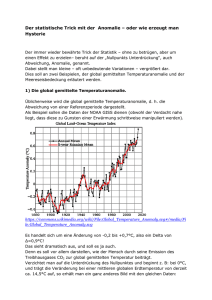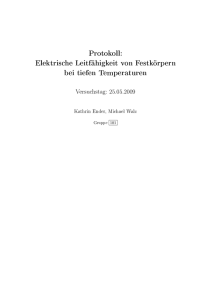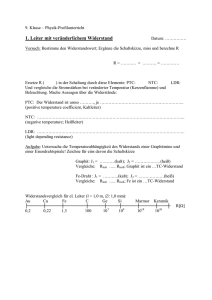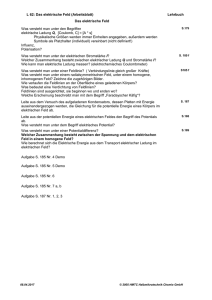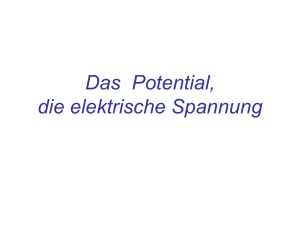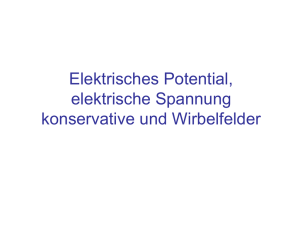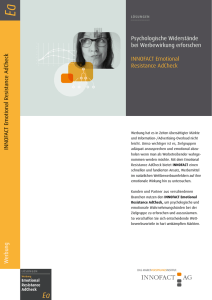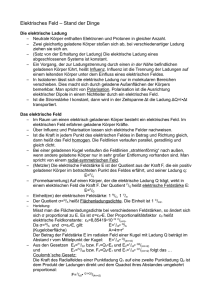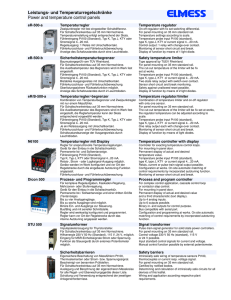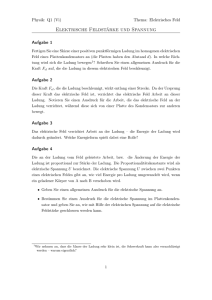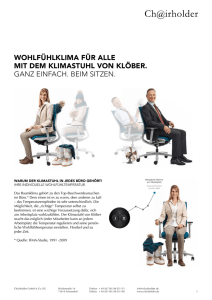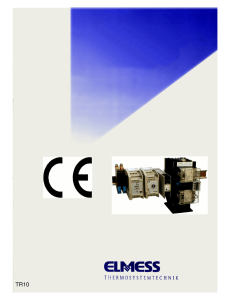ZÁKLADY ELEKTROTECHNIKY 1
Werbung
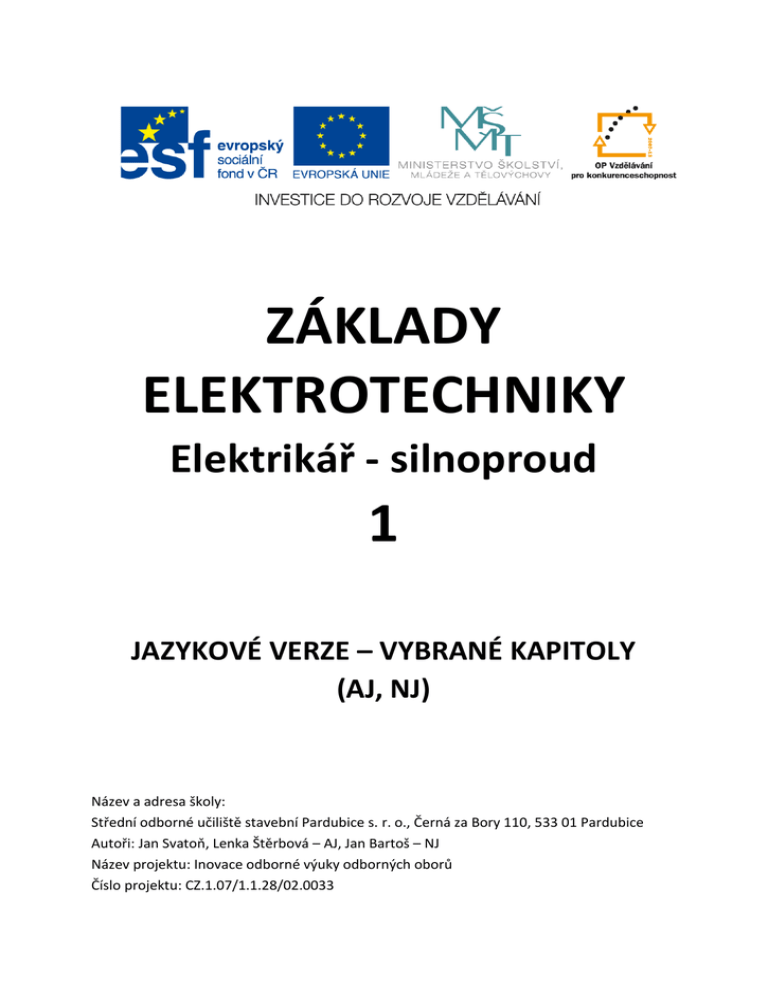
ZÁKLADY ELEKTROTECHNIKY Elektrikář - silnoproud 1 JAZYKOVÉ VERZE – VYBRANÉ KAPITOLY (AJ, NJ) Název a adresa školy: Střední odborné učiliště stavební Pardubice s. r. o., Černá za Bory 110, 533 01 Pardubice Autoři: Jan Svatoň, Lenka Štěrbová – AJ, Jan Bartoš – NJ Název projektu: Inovace odborné výuky odborných oborů Číslo projektu: CZ.1.07/1.1.28/02.0033 NĚMECKÁ VERZE 1.5 Elektronentheorie Elektrische Ladung Es gibt zwei Arten von elektrischen Ladungen: positiv (+) und negativen (-). Herkömmlicher Stromfluss von dem Pluspol (+) zu negativ (-) wird als ein technischer Stromfluss bezeichnet. Die tatsächliche (physikalische) Richtung von der negativen Klemme (-) zu der Positiven (+). Feststoffe im nichtelektrischen Zustand berechnen beide Arten in gleicher Höhe, es handelt sich um Ladungspartikelgebundene Substanzen. Körper kann positiv oder negativ geladen werden. Positive oder negative Ladungen können voneinander getrennt werden, kann aber nicht die elektrische Ladung einer Art zu sammeln, ohne die gleiche Menge an Ladung entgegengesetzter Polarität. Homogener Ladung abstoßen voneinander, unterschiedliche Gebühren für das Gegenteil angezogen. Um jede elektrische Ladung ein elektrisches Feld. Um eine bewegte elektrische Ladung entsteht Magnetfeld. Die elektrische Ladung Q, der Charakter und die Grundeinheit ist der Coulomb [kulomb]. Definition 1 C: ein elektrischer Strom von 1 A ist durch einen Leiter in 1 Sekunde zu strömen. In der Ingenieurpraxis, verwendet das Gerät Ah (Ampere-Stunden), die 3600 C enthält 1.6 Quellen elektrischer Energie Erzeugung von Strom Elektrische Energie wird in Kraftwerken erzeugt, zum Beispiel: a) b) c) d) e) f) g) Wärmekraftwerken - Einsatz von festen und flüssigen Brennstoffen Kernkraftwerke - Nutzung von Kernumwandlungen (Spaltung) Wasserkraftwerke - mit Hilfe der kinetischen Energie des Wassers Windenergieanlagen - Nutzung der Klimabewegung - Wind Solarstromanlagen - Solarenergienutzung Geothermie-Kraftwerke - mit Wärme aus dem Innern der Erde Gezeitenkraft - Energieverbrauch Flut (das Meer) Den meisten Strom produzieren Wärmekraftwerke (70%) in Kernkraftwerken (25%), Wasserkraftwerke (5%). In den Wärme- und Kernkraftwerken wird die kinetische Energie in mechanische Dampfes durch eine Turbine umgewandelt in mechanische Energie in elektrische Energie umzuwandeln, Synchrongeneratoren (Turbogeneratoren) verwendet, um 3.000 Umdrehungen pro Minute liegen. Die Kosten für den Bau und Betrieb von Kraftwerken ist abhängig von 1 kWh, daher ist ein Versuch, Maschinen mit der höchsten Nennkapazität nutzen. Kapazität der Anlagen im Bereich von 50 bis 1500 MW. Zur Kühlung bei geringem Stromgeneratoren wird Wasserstoff für hohe Leistung verwendet und Wasser verwendet wird. Wasserkraftwerke verwenden die Turbinen (Francis, Kaplan) für eine kleine Drehzahl von 100 Umdrehungen pro Minute, also müssen wir die Zahl der Pol Paare zu erhöhen, um eine Frequenz von 50 Hz zu erzielen. Peltonturbine ist für eine höhere Geschwindigkeit (etwa 300 pro Minute) diese Turbinen sind horizontal ausgelegt. Die Kaplan- und Francis-Turbinen sind vertikal. ANGLICKÁ VERZE 1.3 Construction of materials, electrical resistance Construction of materials Substances are composed of atoms. Atoms have an atomic nucleus, and an electron shell. The atomic nucleus is positively charged, and electron shell is negatively charged. In the atomic nucleus there are protons, and neutrons. The nucleus is kept together by nuclear forces that bind individual particles together. Electrons are maintained at different distances from the nucleus, and their tracks express a part of an atom shell. In each shell there can be only a certain number of electrons. The forces, which are acting on them, prevent the core from its moving away. The unit of electric charge is Coulomb [coulomb] and is denoted by the letter C. If there is the same number of protons and electrons in the atom, the electrical characteristics do not reveal, and therefore the atom is electrically neutral. Electrical resistance = An ability of conductive material to give a certain resistance to the electric current passed through. Artificially created resistances are called resistors and are used in electrical circuits. Conductor resistance depends on the temperature. Room temperature is determined by agreement to 20 ° C. By heating a conductor from temperature of v20 to higher temperature v, the original resistance value of the conductor R20 increase to conductor resistance Rν according to the relation Rν = R20 [1 + αR (ν - ν20)], where αR is a temperature coefficient of resistance. The resistance of metals increases with the rising of interior temperature. For most metals in temperature range between 0 ° C and 100 ° C, there is a resistance dependence on temperature linear. For these metals their resistance could be determined at a general temperature ν, if we know their resistance at a temperature of ν20. For resistive materials, there is the course of the resistance dependence on temperature nonlinear. Therefore, it is necessary to consider an indication of the temperature coefficient for resistive materials only as an indicative. According to the relationship mentioned above, it is impossible to determine the resistance for these metals at a general temperature v. If need be, it is necessary to measure the resistivity at the desired temperature separately. For semiconductors, the value of the temperature coefficient of resistance is negative; this means that with increasing temperature the resistance of the material decreases. When deep cooling of the metals or alloys below a certain critical value the resistance suddenly drops to a very low value. 1.4 Separation of substances by electrical conductivity There is the fixed boundary, which material we consider to be a conductor and which is for a non-conductor. Each non-conductor can conduct electric current in a certain way, and each conductor puts some resistance to an electric current. A metal conductor best converts the electrical current to the greatest distance. Conductors: copper and aluminium, for special purpose uses: gold, silver, brass, bronze and steel. Insulators do not have any particles that allow the passage of electric current. They are used as dielectric and conductor insulation. Thermoplastics such as polyethylene, polyvinyl chloride and other substances such as rubber, paper, wax, mica, glass, ceramics, porcelain are the most commonly used.
